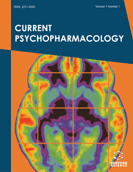Abstract
The search for novel, effective, and safe psychotropic medications for use in children and adolescents is an ongoing journey. Specifically, several atypical antipsychotics have received FDA indications for use in children and adolescents, although carry the risk of potentially serious side effects such as extrapyramidal symptoms, tardive dyskinesia, weight gain, metabolic syndrome, and symptoms of hyperprolactinemia. Three newer antipsychotics – asenapine, iloperidone, and lurasidone – have been considered by some as alternatives to use in children and adolescents with various psychiatric conditions. However, the data on the use of these medications in this population is limited. We review the current literature regarding the use of these agents in children and adolescents. Although these medications may have similar properties to current agents with approved indications, there is not sufficient evidence at this time to recommend their use in children and adolescents. More research is needed regarding the efficacy, safety, and tolerability of these medications in the pediatric population.
Keywords: Adolescents, antipsychotics, asenapine, children, iloperidone, lurasidone.
Current Psychopharmacology
Title:Safety Profile of the Use of Second Generation Antipsychotics in the Child and Adolescent Population
Volume: 3
Author(s): Michael Shapiro, Mariam Rahmani, Adrienne Eisner and Mathew Nguyen
Affiliation:
Keywords: Adolescents, antipsychotics, asenapine, children, iloperidone, lurasidone.
Abstract: The search for novel, effective, and safe psychotropic medications for use in children and adolescents is an ongoing journey. Specifically, several atypical antipsychotics have received FDA indications for use in children and adolescents, although carry the risk of potentially serious side effects such as extrapyramidal symptoms, tardive dyskinesia, weight gain, metabolic syndrome, and symptoms of hyperprolactinemia. Three newer antipsychotics – asenapine, iloperidone, and lurasidone – have been considered by some as alternatives to use in children and adolescents with various psychiatric conditions. However, the data on the use of these medications in this population is limited. We review the current literature regarding the use of these agents in children and adolescents. Although these medications may have similar properties to current agents with approved indications, there is not sufficient evidence at this time to recommend their use in children and adolescents. More research is needed regarding the efficacy, safety, and tolerability of these medications in the pediatric population.
Export Options
About this article
Cite this article as:
Shapiro Michael, Rahmani Mariam, Eisner Adrienne and Nguyen Mathew, Safety Profile of the Use of Second Generation Antipsychotics in the Child and Adolescent Population, Current Psychopharmacology 2014; 3 (2) . https://dx.doi.org/10.2174/221155600302150302112302
| DOI https://dx.doi.org/10.2174/221155600302150302112302 |
Print ISSN 2211-5560 |
| Publisher Name Bentham Science Publisher |
Online ISSN 2211-5579 |
 13
13
- Author Guidelines
- Bentham Author Support Services (BASS)
- Graphical Abstracts
- Fabricating and Stating False Information
- Research Misconduct
- Post Publication Discussions and Corrections
- Publishing Ethics and Rectitude
- Increase Visibility of Your Article
- Archiving Policies
- Peer Review Workflow
- Order Your Article Before Print
- Promote Your Article
- Manuscript Transfer Facility
- Editorial Policies
- Allegations from Whistleblowers
- Announcements
Related Articles
-
Kv1.5 Blockers for the Treatment of Atrial Fibrillation: Approaches to Optimization of Potency and Selectivity and Translation to In Vivo Pharmacology
Current Topics in Medicinal Chemistry Cardiac Adrenomedullin: Its Role in Cardiac Hypertrophy and Heart Failure
Current Medicinal Chemistry - Cardiovascular & Hematological Agents Inhibition of Renin-Angiotensin System and Advanced Glycation End Products Formation: A Promising Therapeutic Approach Targeting on Cardiovascular Diseases
Cardiovascular & Hematological Agents in Medicinal Chemistry Hypersensitivity Reactions to Anticoagulant Drugs
Current Pharmaceutical Design Anesthetic Pharmacology and Perioperative Considerations for Heart Transplantation
Current Clinical Pharmacology Targeted Inhibition of AKT in Pancreatic Cancer
Current Cancer Therapy Reviews Cardiovascular Risk in Patients with Primary Hyperparathyroidism
Current Pharmaceutical Design Safety of Spinal Anesthesia in a Patient with Achondroplasia for Cesarean Section
Current Drug Safety Epidemiological and Clinical Data of Amniotic Fluid Embolism in Forensic Settings
Current Pharmaceutical Biotechnology Targeting Microglial Activation in Stroke Therapy: Pharmacological Tools and Gender Effects
Current Medicinal Chemistry The Use of Nitric Oxide Synthase Inhibitors in Inflammatory Diseases: A Novel Class of Anti-Inflammatory Agents
Current Medicinal Chemistry - Anti-Inflammatory & Anti-Allergy Agents Anti-Saccharomyces Cerevisiae as Unusual Antibody in Autoimmune Polyglandular Syndrome Type III: A Case Report
Endocrine, Metabolic & Immune Disorders - Drug Targets Relaxin as a Cardiovascular Drug: A Promise Kept
Current Drug Safety Liposomal-All-trans-Retinoic Acid in the Treatment of Acute Promyelocytic Leukemia
Current Cancer Therapy Reviews Ethnobotanical Survey of Medicinal Plants used to Treat Cardiovascular Disorders in Ghasemloo Valley of Urmia City
Cardiovascular & Hematological Agents in Medicinal Chemistry Role of Vascular Endothelial Growth Factor in Kidney Disease
Current Vascular Pharmacology Human Immunodeficiency Virus-Associated Malignancies: A Therapeutic Update
Current HIV Research Roles of Adrenomedullin in Hypertension and Hypertensive Organ Damage
Current Hypertension Reviews Pharmacological and Biological Activities of Benzazepines: An Overview
Current Bioactive Compounds Xanthine Derivatives in the Heart: Blessed or Cursed?
Current Medicinal Chemistry


























